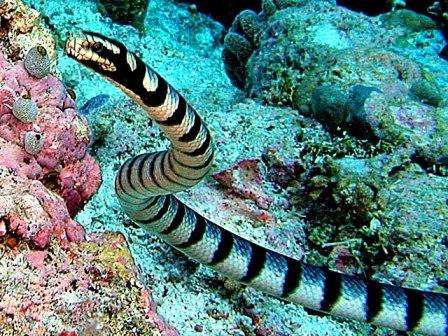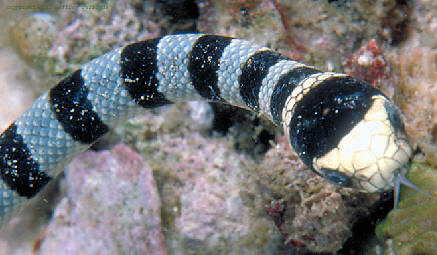Sea Snake
|
Sea snakes are aquatic rather than land dwelling snakes. True sea snakes only live in water. They have adapted to a life in water and have small flattened heads that minimizes water resistance when they swim. The Sea Snakes' body is compressed as an adaptation for swimming and the snakes are so thoroughly aquatic that they are either clumsy or slow when brought ashore. Sea snakes are confined to the tropical oceans, chiefly the Indian Ocean and the western Pacific Ocean. They like warm, tropical waters, however, when the water gets too warm, they swim down to cooler temperatures. The yellow-bellied sea snake extends to the eastern Pacific. The olive sea snake tends to live in reefs. The yellow-bellied sea snake is pelagic (living in open oceans or seas rather than waters adjacent to land or inland waters) and is seen on occasions floating in massive groups. Fish that come up to shelter under slicks provide food for the snakes. Occasionally these yellow-bellied sea snakes get washed up on beaches after storms and pose a hazard to children. Sea snakes are aggressive only during the mating season in the winter, the sea snake is very curious and they become fascinated by elongated objects such as high pressure hoses.
The Sea snakes' favourite food is fish. They prey on fish (including eels) and crustaceans. A couple of species are specialised in eating fish eggs. Others are specialised in eating certain fish species.
Sea Snakes are only moderately large, rarely exceeding 2 metres in length, often with peculiarly small heads for their body size. Similar to cetaceans, their lungs still require them to surface occasionally to breathe. Oxygen intake through the skin has been demonstrated in sea snakes. Transmitters attached to yellow-bellied sea snakes show they can dive to about 150 feet and can stay underwater for more than three hours. Like seabirds and sea turtles, sea snakes have special glands that collect extra salt from the blood. The snake’s salt glands lie beneath their tongues. Each time a sea snake flicks its tongue, it is ejecting salt back into the ocean. Sea snakes have specialized flattened tails for swimming and have valves over their nostrils which are closed underwater. Unlike eels, sea snakes lack gills or fins, instead having scales and spending much of their time underwater, they must surface regularly to breathe.
The venom from a sea snake is generally more toxic to humans than venom from land snakes. Their venom is extremely potent, and a complete envenomation by an adult sea snake may contain enough venom to kill 3 adult people. Their fangs are however only 1 inch to 1˝ inch long and sea snakes are less efficient at penetrating human skin than terrestrial snakes. They are however more inclined to humans if felt threatened than land snakes. Sea snakes' venom contains some of the same chemicals found in cobra venom, only more concentrated in form. Symptoms are attributable to multiple organ systems, with neurological symptoms predominating. They may occur as early as 5 minutes or as late as 8 hours following the bite, but they usually occur within 2 hours. It is possible to get antivenin against all sea snake bites.
|

